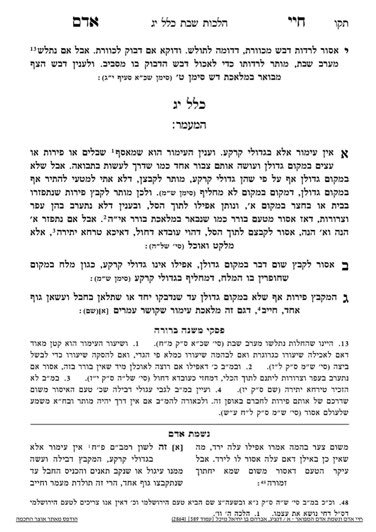Sponsorships for the upcoming Klalim, which discuss the 39 melachos of Shabbos, are available. Please contact Rabbi Reingold for more information at rabbireingold@gmail.com or 301.996.5910
We have begun Klal 14, discussing the melacha of dosh. We left off trying to define the melacha, and we learned that one explanation is that dosh refers to breaking apart items which were attached to each other, while borer refers to independent items in a mixture. This explanation fits with the Gemara which discusses a case in which a person causes a cluster of fruits to detach from their tree, and the Gemara concludes it is a form of dosh (in addition to kotzair). This Gemara would support the idea that dosh is defined as separating items which are connected.
The problem is that milking is also considered (by many rishonim) to be dosh, yet there is nothing attached to something else. If so, milking does not fit with out definition of dosh.
Another explanation for the melacha of dosh is that it refers to where the items surround the other item, even if not attached, per se.
The Chayei Adam, however, combines the two. He writes that the melacha of dosh refers to separating food from its stalk or pod. Additionally, any time one separates the pieces and breaks them apart from that which they were connected to is also dosh. For example, if a person squeezes liquid from a grape, they are performing the melacha of sechita (which falls under dosh), one does not have to understand that the liquid of the grape is attached to the grape, per se, but that the fact they have been separated is the reason for chiyuv. In this manner, we can understand the chiyuv for milking, in that milking separates the milk from the udder even though the milk is not attached, per se, to the udder. Similarly, regarding breaking the kernels off of their stalks, the kernel is held by the husk and attached to it, so separating them is dosh. The same applies to removing beans from a pod.
The issur of dosh applies even if one plans to eat the food immediately. When it comes to borer, it is permitted to sort for immediate use. When it comes to dosh, one is breaking the item apart, which for our purposes is considered attached. There is no heter of immediate use in the melacha of dosh.
The Chayei Adam clarifies that if the pod is edible, we do not consider the pods to be separate entities. Therefore, breaking it apart is muttar and there is no concern of dosh. In a similar manner, it is muttar to break apart two edible foods or two sides of one food.
When it is assur to break apart a food, it is assur even if one wishes to break it apart with a shinui. On the other hand, if it is muttar because it is edible, no shinui is necessary.
Summary
- Dosh refers to the melacha of threshing, which is to separate stalks from their kernels.
- Dosh is defined as separating items which surround one another, even if not attached per se.
- Dosh is different from borrer, because dosh assumes that the items are attached, and borrer is a mixture which is not necessarily attached.
- There is no heter of immediate use or shinui for dosh.



